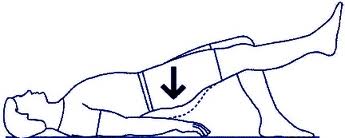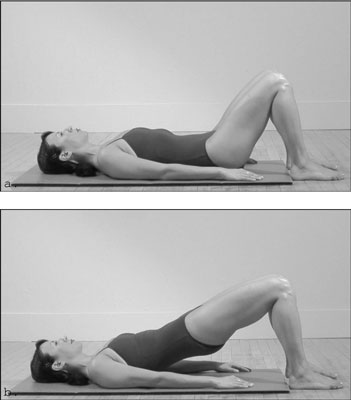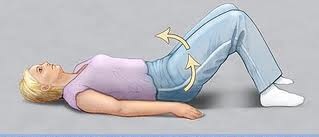Bridging
Original Editor - Daan Vandebriel Sheik Abdul Khadir.
Top Contributors - Sheik Abdul Khadir, Lucinda hampton, Kim Jackson, Uchechukwu Chukwuemeka, Daan Vandebriel, Lilian Ashraf, Mostafa Shahien, Garima Gedamkar, WikiSysop, Evan Thomas and Claire Knott
Description[edit | edit source]
Bridging exercise, a closed chain weight-bearing exercise,is an exercise which increases muscular strength of the hip extensors and promotes trunk stability. It is often prescribed for patients with back pain , and increases the activities of trunk stabilization muscles such as the internal oblique, external oblique, and erector spinae muscles.[1]
Individuals with back and hip pathologies are often taught to perform the bridging exercise in the crook-lying position, elevating the pelvis off the floor. This exercise is particularly useful for facilitating pelvic motions and strengthening the low back and hip extensors, and it enhances motor control of the lumbo-pelvic region.[2]
Technique[edit | edit source]
The patient lies down with the back, knees in full flexion and feet flat on the floor and close to the buttock. Then the patient lifts hip off the floor towards the ceiling/sky as high as possible.
Starting Position to end:
| [3] | [4] |
Movement Analysis[edit | edit source]
Variations [edit | edit source]
The pelvic bridging exercise can be varied as
2. with straight leg raising (SLR) 
3. With SLR and Glutei contraction 
Recently , Changes in the Activities of the Trunk Muscles in Different Kinds of Bridging Exercises has been evaluated by Kong YS et al [5] The authors concluded that Bridging exercise in the prone position may be a more effective method of enhancing trunk muscle activities. The authors evalauted the trunk muscle activities in
- Supine bridging exercise
- Supine bridging on balance pads
- Unilateral bridging
- Prone bridging on the elbows and toes
References[edit | edit source]
- ↑ Min YE,Sin HC,Tae SK. Effects of Bridging Exercise on Different Support Surfaces on the Transverse Abdominis. Journal of Physical Therapy Sciences, 2013; 25:1343–1346.
- ↑ Eun-Mi Jang, Mi-Hyun Kim,Jae-Seop Oh. Effects of a Bridging Exercise with Hip Adduction on the EMG Activities of the Abdominal and Hip Extensor Muscles in Females. Journal of Physical Therapy Sciences, 2013; 25:1147–1149.
- ↑ Bridging. Available from: https://www.youtube.com/watch?v=syoirIxumiY
- ↑ Bridging with progressions tightness Available from: https://www.youtube.com/watch?v=qaoa9V-bL9c
- ↑ Kong YS,Cho YH,Park JW. Changes in the activities of the trunk muscles in different kinds of bridging exercises. J Phys Ther Sci. 2013;25(12):1609-12








